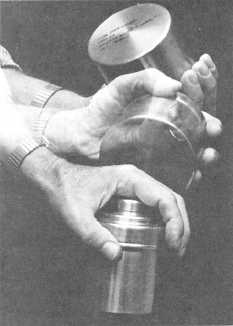303.41
Figure 10-19.–Agitation of a small tank.
fixer into the sink. The fixer can be reused and then later
saved for silver recovery.
11. The film can be washed either in the tank or in
a roll-film washer. When the tank is used, insert a hose
down through the center of the reels until it is about 1/2
inch from the bottom of the tank. Adjust the water (at
the same temperature the film was processed) so a
steady overflow is created. Wash the film for about 20
minutes. When you use a rapid roll-film washer, again,
adjust the water temperature and place the reels
containing the processed film into the washer. Adjust the
rate of water flow until the reels start to turn. When the
reels start to turn, adjust the rate of water flow until the
reels stop turning. Set the timer and wash the film for
about 5 minutes.
12. While the film is washing, rinse the processing
tank, tank cover, and cap with clean water. Fill the tank
with water (check the temperature) and add the wetting
agent. After the film has been washed, place the film,
still on the reels, into the wetting agent solution. Replace
the tank cover and cap and agitate the film in the wetting
solution very S-L-O-W-L-Y for 1 minute.
13. After 1 minute in the wetting solution, remove
the loaded film reels from the tank. (Do not save the
wetting solution.)
14. To dry the film, attach the end of the film to a
film clip in the drying cabinet. Let the film unwind from
the reel as you slowly lower the reel.
When the film is unwound, depress the grip clip (if
the reel has one) or remove the film from the core of the
reel. Squeegee the film and attach a second film clip to
the lower end of the film. Close the drying cabinet door
and dry the film.
Photographer’s Data Sheets
Sometimes a photographer's data sheet will
accompany film that enters your imaging facility to be
processed. The photographer's data sheet will provide
you with information on how the film was shot, lighting
conditions, and specific processing instructions. When
a photographer's data sheet accompanies the film or job
order, you should process the materials specified by the
form.
Cleaning Up
10-25
After processing, the darkroom and all equipment
must be cleaned up immediately. Rinse thoroughly all
processing equipment: tanks, reels, hangers,
thermometers, funnels, and so forth, in clean, warm
water. Place the clean equipment where it can dry before
it is needed for the next processing run. Always keep the
processing room shipshape.
REVERSAL PROCESSING
Normal processing of black-and-white film
produces a negative; from this negative, a positive is
made. However, by using the reversal process, you can
produce a positive image directly on the
black-and-white film.
In the reversal process, a negative image is first
obtained by developing the original latent image in a
developer that contains a silver halide solvent. This
developer dissolves some of the excess silver halides.
After leaving the developer, the negative image is
dissolved away in a bleach bath. The silver halides
remaining are chemically “exposed” (fogged) and
developed by a second developer that provides the
positive image.
Not all black-and-white films reverse well. Films
that reverse well are Kodak Direct Positive
Panchromatic Film 5246 (35mm), T-max 100 Direct
Positive Film, and Kodak Technical Pan Films (35mm).
Instructions for reversal processing of these films can
be found in the Photo-Lab-Index.


